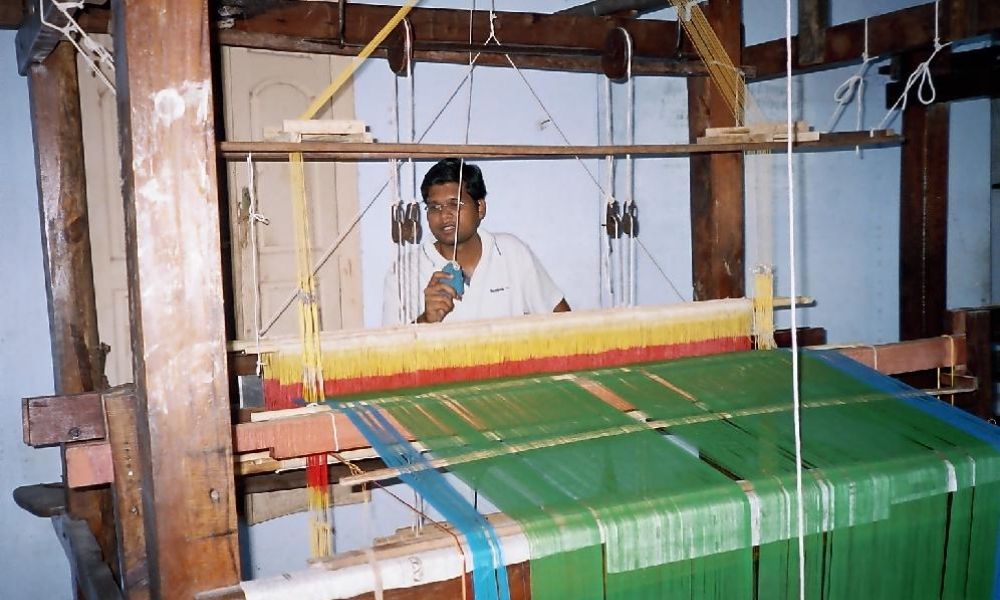
Image Credit: Wikipedia
#MyHandloomMyPride: Why India Should Go Swadeshi In 21st Century
Writer: Ratika Rana
Her primary objective is to inform, promote, educate and cultivate readers through writing.
India, 7 Aug 2021 8:38 AM GMT
Editor : Palak Agrawal |
Palak a journalism graduate believes in simplifying the complicated and writing about the extraordinary lives of ordinary people. She calls herself a " hodophile" or in layman words- a person who loves to travel.
Creatives : Ratika Rana
Her primary objective is to inform, promote, educate and cultivate readers through writing.
In a bid to popularise handmade and handwoven products, PM Narendra Modi gave a green signal to the first National Handloom Day in 2015. Since then, going vocal for local has become one of the prime objectives of the government to promote and protect the weaving industry in the country.
India has the oldest, largest, and most widespread weaving industry in the world. From Phulkaris of Punjab to Kanchipuram sarees from Tamil Nadu; Paithani weavers of Maharashtra to the Benarasi brocades of Uttar Pradesh, the rich history of handloom has always been a crowning glory for the country.
At the same time, the literal definition of handloom states 'any loom other than power loom'. However, the definition has drastically changed over the years.
Popularity Of The Craft Declined Considerably
In 2012, a new definition of handloom emerged. Handloom was defined as any loom other than a power loom and included a hybrid loom on which at least one weaving process required human intervention for production.
The popularity of handloom had declined considerably with the evolution of technology in the textile industry. Hinting at this, it is said that any village comprising of weavers would testify that if there were five handlooms in a house less than a decade-and-a-half earlier, finding one loom among five households would be considered a stroke of luck. If there were 65.51 lakh handloom households in India in1995-1996, the recent handloom census showed just 31.44 lakh of them left in 2019-2020.
What Is The Significance Of This Day?
After the partition of Bengal by the Britishers, the Swadeshi Movement started gaining momentum. On August 7, 1905, a formal proclamation was made in the Calcutta Town Hall to boycott foreign goods and choose made-in-India products. More than a century later, Prime Minister Narendra Modi gave a green signal to the first National Handloom Day in 2015. It was a salute to the weavers of the country for their unrelenting hard work and struggle.
According to the Confederation of Indian Textile Industry, the cotton weavers from Andhra Pradesh, Telangana, and Maharashtra had to travel long distances because of the unavailability of cotton in nearby places. On the other hand, the small weavers could not afford to buy bulk orders since they could not afford the extravagant transportation costs.
The Indian Express reported that the budget allocation to the textile industry for 2019-2020 was reduced to ₹4,891 crores from ₹6,943 crores in the previous fiscal. This meant that several subsidies and schemes for weavers like health and housing also declined. The situation leaves the small weavers at the mercy of money lenders who charge massive interests.
Why Is The Industry On Decline?
Lack of proper infrastructure, older looms, and inaccessibility to reach prime markets have added to the struggles of weavers across the country. Even though several organisations are helping the local communities to reach customers directly, there is a dire need to make the industry a level playing field for all big and small weavers.
Currently, there are 13 government schemes for the welfare of the weavers; only 3 per cent of them are aware of Weavers' Health Insurance scheme, and only 10.5 per cent know and can avail themselves of the credit waivers for them.
To truly celebrate National Handloom Day, the government must enhance adequate research and development, awareness and enable the accessibility to prime markets. Easy access to the welfare schemes and better credit support can make a difference in the lives of these culture-preservers of the country.
Also Read: 'Every Child Has Right To Use Mother's Surname': Delhi High Court
 All section
All section














